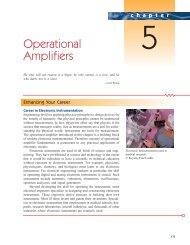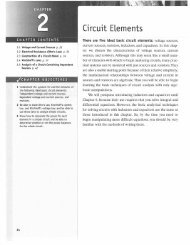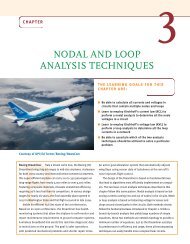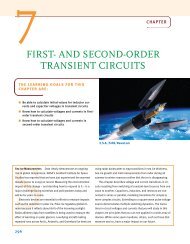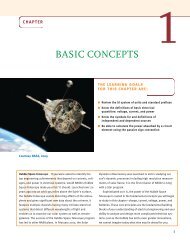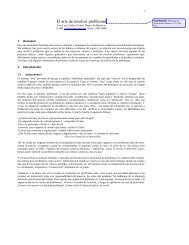Fundamentals of Electric Circuits
Fundamentals of Electric Circuits
Fundamentals of Electric Circuits
You also want an ePaper? Increase the reach of your titles
YUMPU automatically turns print PDFs into web optimized ePapers that Google loves.
Review Questions 113<br />
4. A supermesh consists <strong>of</strong> two meshes that have a (dependent or<br />
independent) current source in common.<br />
5. Nodal analysis is normally used when a circuit has fewer node<br />
equations than mesh equations. Mesh analysis is normally used<br />
when a circuit has fewer mesh equations than node equations.<br />
6. Circuit analysis can be carried out using PSpice.<br />
7. DC transistor circuits can be analyzed using the techniques covered<br />
in this chapter.<br />
Review Questions<br />
3.1 At node 1 in the circuit <strong>of</strong> Fig. 3.46, applying KCL<br />
gives:<br />
(a) 2 12 v 1<br />
3<br />
(b) 2 v 1 12<br />
3<br />
(c) 2 12 v 1<br />
3<br />
(d) 2 v 1 12<br />
3<br />
v 1<br />
6 v 1 v 2<br />
4<br />
v 1<br />
6 v 2 v 1<br />
4<br />
0 v 1<br />
6<br />
0 v 1<br />
6<br />
v 1 v 2<br />
4<br />
v 2 v 1<br />
4<br />
3.3 For the circuit in Fig. 3.47, v 1 and v 2 are related as:<br />
(a) v 1 6i 8 v 2 (b) v 1 6i 8 v 2<br />
(c) v 1 6i 8 v 2 (d) v 1 6i 8 v 2<br />
v 1<br />
6 Ω<br />
8 V<br />
12 V + i<br />
− 4 Ω<br />
Figure 3.47<br />
For Review Questions 3.3 and 3.4.<br />
− +<br />
v 2<br />
12 V + −<br />
2 A<br />
8 Ω<br />
3 Ω v 1 4 Ω<br />
1 2<br />
v 2<br />
6 Ω 6 Ω<br />
3.4 In the circuit <strong>of</strong> Fig. 3.47, the voltage is:<br />
(a) 8 V (b) 1.6 V<br />
(c) 1.6 V<br />
(d) 8 V<br />
3.5 The current i in the circuit <strong>of</strong> Fig. 3.48 is:<br />
(a) 2.667 A (b) 0.667 A<br />
(c) 0.667 A<br />
(d) 2.667 A<br />
v 2<br />
Figure 3.46<br />
For Review Questions 3.1 and 3.2.<br />
3.2 In the circuit <strong>of</strong> Fig. 3.46, applying KCL at node 2<br />
gives:<br />
v 2 v 1<br />
(a)<br />
4<br />
v 1 v 2<br />
(b)<br />
4<br />
v 1 v 2<br />
(c)<br />
4<br />
(d) v 2 v 1<br />
4<br />
v 2<br />
8 v 2<br />
6<br />
v 2<br />
8 v 2<br />
6<br />
12 v 2<br />
8<br />
v 2 12<br />
8<br />
v 2<br />
6<br />
v 2<br />
6<br />
4 Ω<br />
10 V + − i<br />
+ − 6 V<br />
2 Ω<br />
Figure 3.48<br />
For Review Questions 3.5 and 3.6.<br />
3.6 The loop equation for the circuit in Fig. 3.48 is:<br />
(a) 10 4i 6 2i 0<br />
(b) 10 4i 6 2i 0<br />
(c) 10 4i 6 2i 0<br />
(d) 10 4i 6 2i 0




